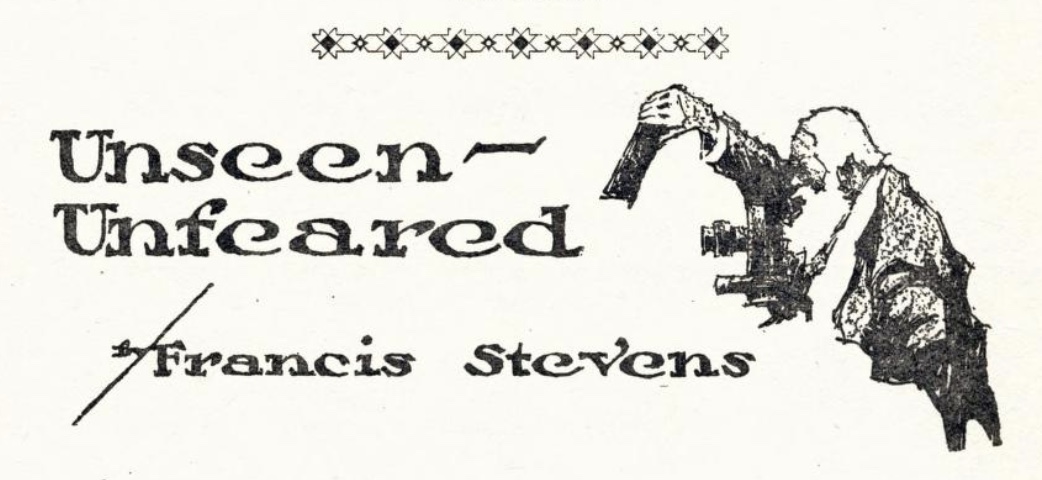UNSEEN — UNFEARED (6)
By:
August 12, 2023

“Unseen — Unfeared” was originally published in the February 10, 1919 edition of People’s Favorite Magazine. HiLoBooks is pleased to serialize it here for HILOBROW’s readers.
ALL INSTALLMENTS: 1 | 2 | 3 | 4 | 5 | 6 | 7 | 8 | 9 | 10.
Again I struggled within me, bit at my lip till I tasted blood, and presently the blind paroxysm passed. It must have been longer in going than I thought, and the old man must have all that time been speaking, for when I could once more control my attention, hear and see him, he had taken up a position near the sink, about ten feet away, and was addressing me with a sort of “platform” manner, as if I had been the large audience whose absence he had deplored.
“And so,” he was saying, “I was forced to make these plates very carefully, to truly represent the characteristic hues of each separate organism. Now, in color work of every kind the film is necessarily extremely sensitive. Doubtless you are familiar in a general way with the exquisite transparencies produced by color photography of the single-plate type.”
He paused, and, trying to act like a normal human being, I observed: “I saw some nice landscapes done in that way—last week at an illustrated lecture in Franklin Hall.”
He scowled, and made an impatient gesture at me with his hand. “I can proceed better without interruptions,” he said. “My pause was purely oratorical.”
I meekly subsided, and he went on in his original loud, clear voice. He would have made an excellent lecturer before a much larger audience—if only his voice could have lost that eerie, ringing note. Thinking of that I must have missed some more, and when I caught it again he was saying:
“As I have indicated, the original plate is the final picture. Now, many of these organisms are extremely hard to photograph, and microphotography in color is particularly difficult. In consequence, to spoil a plate tries the patience of the photographer. They are so sensitive that the ordinary darkroom ruby lamp would instantly ruin them, and they must therefore be developed either in darkness or by a special light produced by interposing thin sheets of tissue of a particular shade of green and of yellow between lamp and plate, and even that will often cause ruinous fog. Now I, finding it hard to handle them so, made numerous experiments with a view to discovering some glass or fabric of a color which should add to the safety of the green, without robbing it of all efficiency. All proved equally useless, but intermittently I persevered—until last week.”
His voice dropped to an almost confidential tone, and he leaned slightly toward me. I was cold from my neck to my feet, though my head was burning, but I tried to force an appreciative smile.
“Last week,” he continued impressively, “I had a prescription filled at the corner drug store. The bottle was sent home to me wrapped in a piece of what I at first took to be whitish, slightly opalescent paper. Later I decided that it was some kind of membrane. When I questioned the druggist, seeking its source, he said it was a sheet of ‘paper’ that was around a bundle of herbs from South America. That he had no more, and doubted if I could trace it. He had wrapped my bottle so, because he was in haste and the sheet was handy.
“I can hardly tell you what first inspired me to try that membrane in my photographic work. It was merely dull white with a faint hint of opalescence, except when held against the light. Then it became quite translucent and quite brightly prismatic. For some reason it occurred to me that this refractive effect might help in breaking up the actinic rays—the rays which affect the sensitive emulsion. So that night I inserted it behind the sheets of green and yellow tissue, next the lamp, prepared my trays and chemicals, laid my plate holders to hand, turned off the white light and—turned on the green!”
RADIUM AGE PROTO-SF: “Radium Age” is Josh Glenn’s name for the nascent sf genre’s c. 1900–1935 era, a period which saw the discovery of radioactivity, i.e., the revelation that matter itself is constantly in movement — a fitting metaphor for the first decades of the 20th century, during which old scientific, religious, political, and social certainties were shattered. More info here.
SERIALIZED BY HILOBOOKS: James Parker’s Cocky the Fox | Annalee Newitz’s “The Great Oxygen Race” | Matthew Battles’s “Imago” | & many more original and reissued novels and stories.
